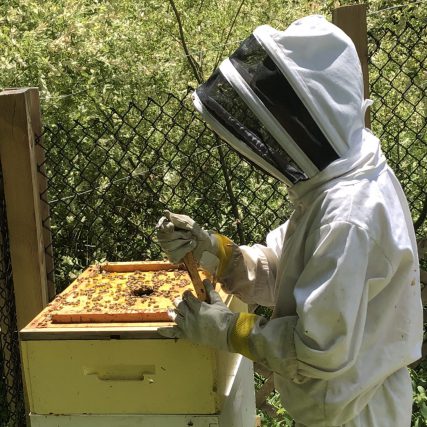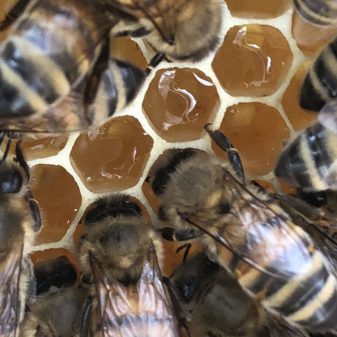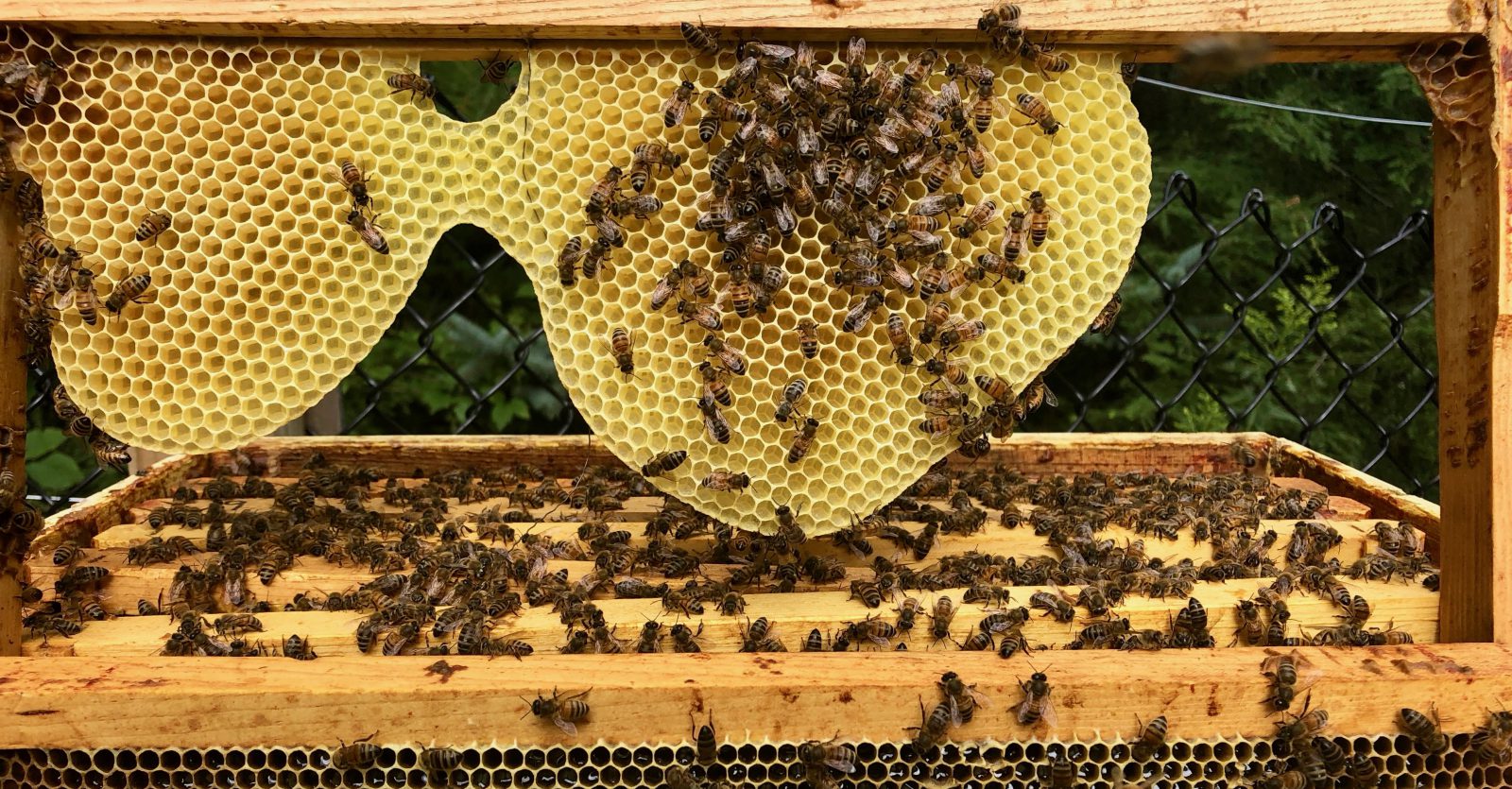Beekeeping may seem like a real challenge if you have no idea where to start. We spoke with local beekeeper, Gwynne Berry, and got the scoop on what it takes to make your own honey. Read on to learn more about the supplies you’ll need to get started, and discover how important bees are to everything around us!
Beekeeping for Beginners
How did you become interested in beekeeping?
I have been beekeeping for about 6 years now. I was drawn in by the idea of harvesting your own honey, but very quickly became fascinated with the bees themselves. They have a matriarchal social structure with the queen living for 2-3 years and the males (drones) living for 6-8 weeks. The video below shows a baby bee coming out of its cell.
I love how for each stage of life, the bee has a specific job. It’s amazing how much a single female worker bee accomplishes in her 45 day lifetime. Days 1-11: Nurse Bees take care of the brood and clean the cells. Days 12-17: Funeral Bees remove the dead, make wax, and carry food. Days 18-21: Guard Bees protect the hive, check every bee that enters, and takes care of any intruders. Days 22-45 (and beyond): Field Bees go from flower to flower collecting pollen.
What kind of advice would you give beginners and those thinking about beekeeping?
Research! Read books and watch videos. Join or follow a local beekeeping group. These will give you the step-by-step guides on how to set up and take care of your hive, as well as tell you what NOT to do – which is extremely helpful! I also took a small “Intro to Beekeeping” class. The running joke is that there are as many ways and styles of beekeeping as there are beekeepers!
What does it take to get started with beekeeping?
Most beekeeping catalogues will have a starter set to choose from (try Betterbee out of the Adirondacks). I think if you are able, start with two hives — it is better than one. It allows for diversity, and if one hive gets into trouble, you can supplement brood from the other hive. I always try to get bees that are adapted to the Vermont seasons. Finally, I prefer starting with a nuc (five full frames of drawn comb and brood) versus a package of bees (no comb or brood). Our season is short and it is best to start with the strongest bees you can.
How much time does beekeeping take, and is it seasonal?
Starting around April through November, you can expect to go into the hive every three weeks or so. Most of the time it will only take 5 to 10 minutes – just a quick peak to see how full the frames are and determine if a new box needs to go on. Other times you will need to do a full inspection. A full inspection needs to be done on a warm sunny day and will take some time – especially for new beekeepers. Because of this, it is best to watch a video first so you’ll know what to expect.
When I first started out, I went into the hive all the time. I was fascinated (and still am) by how the bees lived, worked and communicated with each other. However, this will stress your bees out. It is actually possible to love your bees to death – I once had a hive abscond because I went in too often and they felt unsafe.
Once winter arrives, you will just check to make sure that no snow is covering their entrances and perhaps occasionally scrape out the dead from the bottom. Overall, it is very low maintenance.




What tools are required for beekeeping?
Above all, a good bee suit will be one of your most important investments. I like the full suit because it allows me to feel relaxed and not worried that a bee has snuck its way in! In the spring, the bees are very docile — They are focused on growing and feeding the hive. I often will come and sit right next to a hive in nothing but shirt and pants! I love to listen to the different sounds of the hive and watch the foragers come and go. It is fascinating to see all the different colors of pollen! However, in the fall, the bees will become more aggressive. They are territorial and protective of their winter food supply and do not want to anyone near the hive. Therefore, the full bee suit is best!
Depending on where you live, you will also want to put up an electric fence. Bears love to snack on the brood (larvae). We had a bear find our hives a few years ago and it was devastating to watch the bear toss and tear them apart. It was a total loss for the bees. The next year we put in a very sturdy electric fence.
Additionally, some other items you’ll need include a hive tool, a brush, and a smoker.
What have you made with your honey and beeswax?
This past year we made beeswax wraps for food. It was so fun and easy, and made for some great gifts! We have also made candles and hand cream — The internet is full of ways to do this! We use the honey in many of our baking and dinner recipes, and we also use it to help with allergies. The next thing we are going try is making kombucha using our honey!




Why are pollinators so important? Do bees help with other aspects of your homesteading(ish) lifestyle?
Bees will travel up to a five mile radius from their hive, and a single bee can pollinate 5,000 flowers in a single day! Our gardens and fruit trees are so much healthier with the bees. Our blueberry bushes have become much more prolific due to help from the ladies. I love seeing the bees go from tomato flower to tomato flower and know that we are helping each other!
What inspires you the most about this process and how does it contribute to your idea of a brighter future?
I love hearing from neighbors that they have seen honeybees on their plants. When we give them honey it’s cool to know that their gardens provided to the honey bees’ stores. My daughter and I have gone to a couple elementary schools to teach kids where honey comes from. It fascinates me to see the interconnection between these insects and the food we eat. It has brought an awareness to our environment on a micro level that we (our family and friends) did not have before.
My hope is that as more people become aware of how important these pollinators are — bees and butterflies — and that they will become more conscious of what they put in the ground. This will certainly help bring about a healthier relationship with the world we all live in.






Did this blog have you BUZZING?!
If you enjoyed this blog and are interested in more home and garden content, you should check out our How to Start a Garden Blog or learn how you can Make Every Day Earth Day!
How do I go solar?
The process for going solar is simple. It starts with filling out our get started form. You can do so by clicking the get started button. If you want to know more details about the process and the steps involved between signing up and turning on the power, click the button below to find out more.





